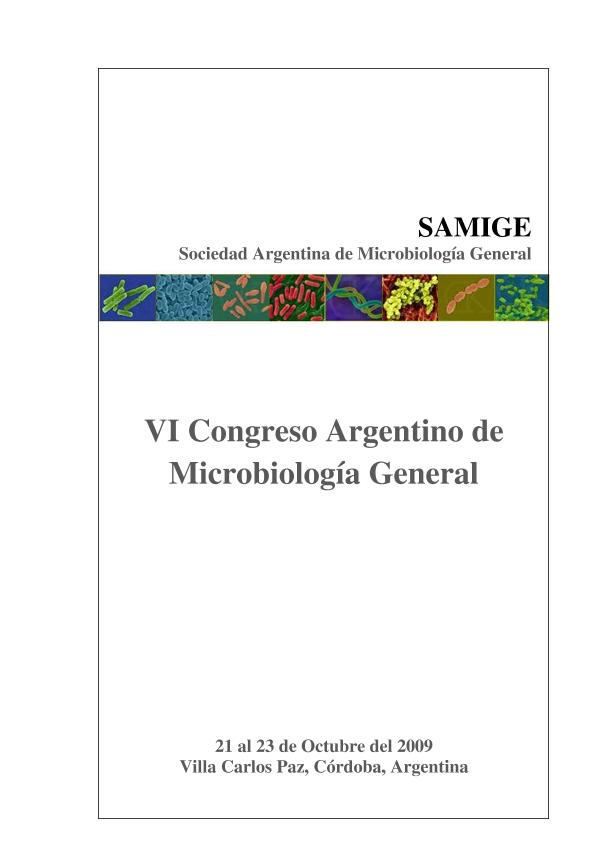Mostrar el registro sencillo del ítem
dc.contributor.author
Nally, Maria Cristina

dc.contributor.author
Pesce, Virginia Mercedes

dc.contributor.author
Toro, Maria Eugenia

dc.contributor.author
Castellanos, Lucia Ines

dc.contributor.author
Vazquez, Fabio

dc.date.available
2023-04-21T18:26:46Z
dc.date.issued
2009
dc.identifier.citation
Determination of the incidence of grey mould on grapes of San Juan, Argentina after applying different concentrations of naturally occurring antagonist yeasts; VI Congreso Argentino de Microbiología General; Córdoba; Argentina; 2009; 63-63
dc.identifier.uri
http://hdl.handle.net/11336/195005
dc.description.abstract
Introduction: Botrytis cinerea is a major pathogen of grape. At present, control in conventional agriculture is mainly achieved through chemical strategies, which can also have many disadvantages, such as the public‟s growing concern for the human health conditions and the environmental pollution. One promising alternative to pesticides is the biological control, numerous studies indicated that some yeast species are ideal biocontrol agents, as they are natural plant epiphytic colonizers, nonpathogenic to plants and human beings in most cases and can rapidly proliferate. It has been reported that biological control was only effective when high concentrations of antagonist yeasts were applied. Objective: The aim of the present work was to study the efficacy of different concentrations of antagonistic yeasts in reducing the development of B.cinerea. Materials and Methods: A- Microorganisms: The pathogen B.cinerea was isolated from infected grapes. All yeast antagonists (15 strains of Saccharomyces cerevisiae and 1 of Schizosaccharomyces pombe) were originally isolated from grape surfaces and fermenting musts. They were selected because of their ability to control B.cinerea on grapes, screening them in vitro and in vivo. B- Tests on fruit: Biocontrol effectiveness was assessed on Red Globe grapes. The fruits were artificially wounded and inoculated with yeasts (10 5, 106 and 107 UFC/ml) and conidial suspension of B.cinerea (104 conidia/ml). Each sample, constituted by 9 berries and reproduced with three replicates for each yeast isolate, was incubated for 5 days at 25°C in a plastic box under high relative humidity (100%). After storage, the incidence of disease was analyzed in percentage and these were arcsin- transformed to angular data prior to ANOVA. Results: There were significant negative relationships between concentration of the antagonists and disease incidence (R2: range on 0.75 to 0.99). The efficacy was higher when a concentration 107 CFU/ml of antagonist was used. When yeast cell suspensions of 8 strains of S.cerevisiae (BSc5, BSc49, BSc81, BSc92, BSc121, BSc140, BSc175 and BSc203) and S.pombe BSc167 reached a concentration of 107 CFU/ml, no infection by B.cinerea was found in fruits treated. Two strains of S.cerevisiae: BSc49 and BSc140 were able to inhibit mycelial growth of grey mould when a concentration of 10 6 CFU/ml of yeasts was inoculated. Conclusions: The concentrations of antagonist had significant effects on biocontrol effectiveness: the higher the concentration of yeast the better biocontrol activity of the antagonist had. When yeast was at 10 7 CFU/ml, the best control was obtained and this concentration was lower than those reported by other investigators.
dc.format
application/pdf
dc.language.iso
spa
dc.publisher
Sociedad Argentina de Microbiología General
dc.rights
info:eu-repo/semantics/openAccess
dc.rights.uri
https://creativecommons.org/licenses/by-nc-sa/2.5/ar/
dc.subject
Grey mould
dc.subject
Grapes
dc.subject
San Juan
dc.subject.classification
Biología Celular, Microbiología

dc.subject.classification
Ciencias Biológicas

dc.subject.classification
CIENCIAS NATURALES Y EXACTAS

dc.title
Determination of the incidence of grey mould on grapes of San Juan, Argentina after applying different concentrations of naturally occurring antagonist yeasts
dc.type
info:eu-repo/semantics/publishedVersion
dc.type
info:eu-repo/semantics/conferenceObject
dc.type
info:ar-repo/semantics/documento de conferencia
dc.date.updated
2023-04-11T12:10:39Z
dc.journal.pagination
63-63
dc.journal.pais
Argentina

dc.description.fil
Fil: Nally, Maria Cristina. Consejo Nacional de Investigaciones Científicas y Técnicas; Argentina. Universidad Nacional de San Juan. Facultad de Ingeniería. Instituto de Biotecnología; Argentina
dc.description.fil
Fil: Pesce, Virginia Mercedes. Consejo Nacional de Investigaciones Científicas y Técnicas; Argentina. Universidad Nacional de San Juan. Facultad de Ingeniería. Instituto de Biotecnología; Argentina
dc.description.fil
Fil: Toro, Maria Eugenia. Universidad Nacional de San Juan. Facultad de Ingeniería. Instituto de Biotecnología; Argentina
dc.description.fil
Fil: Castellanos, Lucia Ines. Consejo Nacional de Investigaciones Científicas y Técnicas. Centro Científico Tecnológico Conicet - Tucumán. Planta Piloto de Procesos Industriales Microbiológicos; Argentina. Universidad Nacional de Tucumán. Facultad de Bioquímica, Química y Farmacia; Argentina
dc.description.fil
Fil: Vazquez, Fabio. Universidad Nacional de San Juan. Facultad de Ingeniería. Instituto de Biotecnología; Argentina
dc.relation.alternativeid
info:eu-repo/semantics/altIdentifier/url/https://samige.org.ar/wp-content/uploads/2022/10/Libro-SAMIGE-2009.pdf
dc.conicet.rol
Autor

dc.conicet.rol
Autor

dc.conicet.rol
Autor

dc.conicet.rol
Autor

dc.conicet.rol
Autor

dc.coverage
Nacional
dc.type.subtype
Congreso
dc.description.nombreEvento
VI Congreso Argentino de Microbiología General
dc.date.evento
2009-10-21
dc.description.ciudadEvento
Córdoba
dc.description.paisEvento
Argentina

dc.type.publicacion
Book
dc.description.institucionOrganizadora
Sociedad Argentina de Microbiología General
dc.source.libro
Libro de resúmenes del VI Congreso Argentino de Microbiología General
dc.date.eventoHasta
2009-10-23
dc.type
Congreso
Archivos asociados
